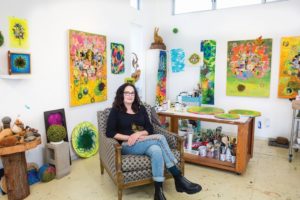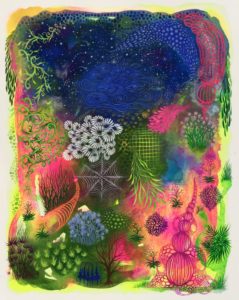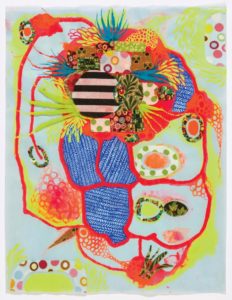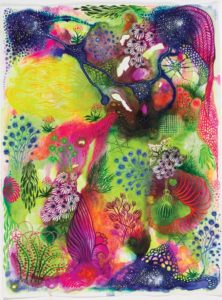Carrie Lederer has a table in her studio in Oakland, Calif. that she describes as “an artist statement in 3D.” It displays things she finds in nature, often from her garden. Recent additions to the collection include a pod from a hornet’s nest, some broken seashells, and branches that she says she admires for the way they “twist and curl and find their natural shape.”

“Each time I stop and tend to something, there’s a discovery,” she says. “It all feeds the work.”
References to the natural world are abundant in Lederer’s vibrantly colored works on paper, currently on view at Farm Projects in Wellfleet. She describes her view of nature as straddling extremes between “macro and micro” and “above and below.”
In Nature’s Mysterious Conglomerates (Eyes in Sky), the environment seems to be both underwater and celestial. Sea grasses snake through a busy field of spider webs and stains of color. A star-studded midnight blue sky hovers above — and even there, swirling vines find their way up to the stars and start to coalesce into biomorphic forms. In another piece, Nature’s Mysterious Conglomerates II, the nighttime sky becomes a network of neurons and synapses. Natural elements exist as a cosmic and wondrous whole, part of her intent to make viewers “see the environment from the recesses of soil to the cosmos beyond us.”

Lederer is also fascinated by fractals as a form of growth that underlies divergent elements in nature. In some of her ecosystems circular shapes bubble outward, flowers emerge from other flowers, and patterns fill empty spaces with an almost invasive sense of expansion. “Each pocket of activity finds connection and entwines with the next,” she says. Other ecosystems in Lederer’s work seem to be in a nascent stage: pieces such as Abstracted Garden (Patches of Blue Herringbone) appear like cells beginning a process of subdivision.
Lederer’s approach to painting echoes the growth of the forms she depicts. She jumps into creative work without planning anything: “I just watch what happens,” she says. Each area she finishes in a painting leads her to the next section. This sense of gradual discovery is evident in Abstracted Garden I, where she establishes an environment with washes of color and improvises and embellishes as she continues. Some areas are filled with marks and gestures, while others include shapes cut from fabric. Her subtle integration of collaged elements feels like a kind of infestation that introduces new textures and elements into the surface.

Working with transparent media on paper makes it difficult for Lederer to completely cover over passages of the image as she reworks her compositions. So, she works additively, building elements in a way that leaves traces of all the creative decisions that came before. She sees this process as similar to the way that nature works: “You add something, and it survives or it doesn’t,” she says. “But there are remnants. It’s like an archeological history that reflects a timeline of natural growth.”
While fluorescent color has become one of the most identifiable elements in Lederer’s work, it’s a relatively recent development for her. “For many years my work was very green,” she says. “But at the start of the pandemic a lot more color came into it. It was a very intense time, and I was looking for a way to heighten what I was experiencing.” Wildfires were also raging in California — an experience she found “frightening but really beautiful” — and the “orange atmosphere” they created also influenced Lederer’s use of color in her work.

“There’s this dichotomy that what is bright and magical can also be dangerous,” she says. Like nature itself, Lederer’s colors can convey a sense of an encroaching force or invasive species — while still remaining beautiful and full of life.
Nature’s Mysterious Conglomerates
The event: An exhibition of works on paper by Carrie Lederer
The time: Through Oct. 2
The place: Farm Projects, 355 Main St., Wellfleet
The cost: Free



